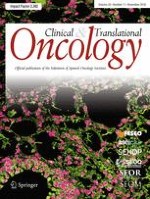Erschienen in:

07.05.2018 | Research Article
Pre-surgical trial of the AKT inhibitor MK-2206 in patients with operable invasive breast cancer: a New York Cancer Consortium trial
verfasst von:
K. Kalinsky, J. A. Sparano, X. Zhong, E. Andreopoulou, B. Taback, L. Wiechmann, S. M. Feldman, P. Ananthakrishnan, A. Ahmad, S. Cremers, A. N. Sireci, J. R. Cross, D. K. Marks, P. Mundi, E. Connolly, K. D. Crew, M. A. Maurer, H. Hibshoosh, S. Lee, D. L. Hershman
Erschienen in:
Clinical and Translational Oncology
|
Ausgabe 11/2018
Einloggen, um Zugang zu erhalten
Abstract
Introduction
The PI3K/AKT/mTOR pathway is an oncogenic driver in breast cancer (BC). In this multi-center, pre-surgical study, we evaluated the tissue effects of the AKT inhibitor MK-2206 in women with stage I–III BC.
Materials and methods
Two doses of weekly oral MK2206 were administered at days − 9 and − 2 before surgery. The primary endpoint was reduction of pAktSer473 in breast tumor tissue from diagnostic biopsy to surgery. Secondary endpoints included changes in PI3K/AKT pathway tumor markers, tumor proliferation (ki-67), insulin growth factor pathway blood markers, pharmacokinetics (PK), genomics, and MK-2206 tolerability. Paired t tests were used to compare biomarker changes in pre- and post-MK-2206, and two-sample t tests to compare with prospectively accrued untreated controls.
Results
Despite dose reductions, the trial was discontinued after 12 patients due to grade III rash, mucositis, and pruritus. While there was a trend to reduction in pAKT after MK-2206 (p = 0.06), there was no significant change compared to controls (n = 5, p = 0.65). After MK-2206, no significant changes in ki-67, pS6, PTEN, or stathmin were observed. There was no significant association between dose level and PK (p = 0.11). Compared to controls, MK-2206 significantly increased serum glucose (p = 0.02), insulin (p < 0.01), C-peptide (p < 0.01), and a trend in IGFBP-3 (p = 0.06).
Conclusion
While a trend to pAKT reduction after MK-2206 was observed, there was no significant change compared to controls. However, the accrued population was limited, due to toxicity being greater than expected. Pre-surgical trials can identify in vivo activity in the early drug development, but side effects must be considered in this healthy population.











